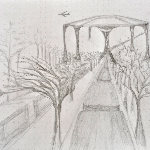Please find below the
Semi-Finalist Evaluation
Judges'' comments
SUBJECT: Your proposal in the Climate CoLab
Proposal: 'Portocielo' - A Skyscraper Airport
Contest: Transportation
Thank you for your contest entry. We appreciate your willingness to share your ideas and also the time and effort you put into developing a proposal and submitting it to the contest.
We, the Judges, have strongly considered your proposal and found that it contained intriguing elements; however, we have chosen to not advance it to the next round of competition.
We encourage you to keep developing your idea. Transfer your proposal to the Proposal Workspace to re-open it, make edits, add collaborators, and even submit it into a future contest. You can do so by logging into your account, opening your proposal, selecting the Admin tab, and clicking “Move proposal”.
We welcome you to stay involved in the Climate CoLab community: support and comment on proposals that have been named Semi-Finalists and finalists, and even volunteer to join one those teams if you have relevant expertise. During the voting period, you can help select the contest’s Popular Choice Winner. The Climate CoLab will be opening more contests in the coming months, and you are welcome to submit your proposals to those contests as well.
Keep up the great work. We hope that by working together, we all can create solutions that wouldn’t otherwise be possible.
2015 Climate CoLab Judges
A few 100 meters don't make a big difference with respect to the amount of energy required to lift a plane into a cruise altitude of 10 km or so. Also, there are significant safety issues. We already witnessed airlines crashing into buildings and we need to try everything to prevent this from happening again.
This is an interesting concept, but it does not strike us as realistically feasible. The reduction in distance to climb by a few hundred meters is unlikely to make that big an impact on fuel burn, although we do like the point about adjusting the take-off trajectory so that aircraft can initially descend in order to gain speed. This could theoretically lead to reductions in engine size. Although longer runways would have a similar effect as less cost.
There are some safety concerns with the technology, especially if these airports were built in cities, or with parks etc. underneath them. An aircraft going off the runway would be considerably more catastrophic than it is today. Having said that, we like the idea of trying to use the space for other activities, like recreation. Its just the safety concern that is the problem, and that is exactly why we don't have parks between runways today.
Unfortunately we think the benefit to cost ratio of this idea is very low. It would presumably be very expensive for a moderate environmental benefit. The cost needs to be estimated in the proposal, as does the environmental benefit. Then this judgement can be made more objectively.
We like the point about nations being able to take independent action to reduce emissions. This is certainly attractive.
(Perhaps an interesting variation of the idea that could be explored are floating docking stations for large blimps. The footprint is smaller and the costs manageable.)
No comments have been posted.
